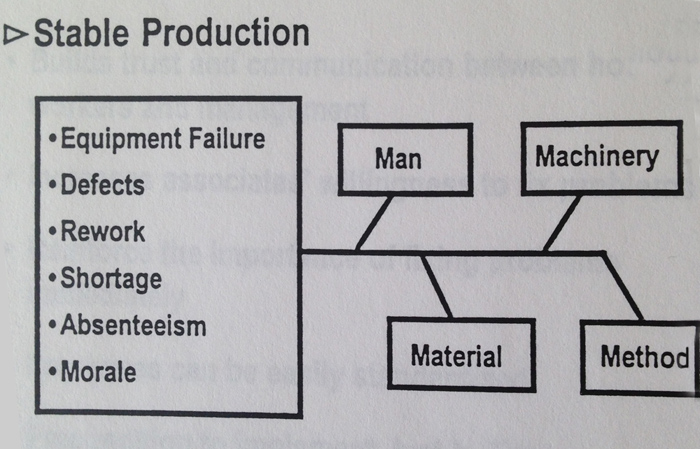(During The Way to Lean, a free webinar on the “lean trilogy” approach to deeply understanding and applying kaizen daily, we received more questions than presenter Michael Ballé could answer during the Q&A session. Michael is answering them, including the question below, in his Gemba Coach column -Ed.)
Dear Gemba Coach,
We are looking to implement gemba walks in our facility. This is new to everyone including myself although I have been exposed to them in the past. What is the best way to get started and keep them focused? How do you train or teach people what to look for?
The trouble with gemba walks is that management on the shop floor can mean big trouble. I remember a senior guy who took a shine to gemba walks and walked everywhere, questioning everything and everyone. What a panic he created! Employees wondered what this very senior exec was doing criticizing all – what was going to happen? What did that mean?
Management on the shop floor can be a blessing or a curse according to how you do it. The first rule of gemba walks is: don’t ask anyone anything. Shut up! Watch! Listen! Learn. Or at least, ask the less, not the more.
What are our main objectives in conducting gemba walks?
- First, we want to assess first-hand the strength and weaknesses of our products, processes, and people – and how serious they are about putting customers first.
- Second, we want to have an idea of how management faces its own problems and how well they involve value-adding people in understanding the problems and contributing.
- Third we want to see how good managers are at creating the conditions for kaizen by establishing good working conditions at the workplace and how supportive there are of teams’ improvement efforts.
The tricky part is that senior managers on the gemba are expected to give clear directions about what should be done – which is often delivered as criticism. But senior managers are also expected to be encouraging and supportive, which means we need to see something to encourage and support. It’s never an easy balance.
Use the 3:1 Rule
My personal rule of thumb, for what it’s worth, is 3:1 – I try to say three encouraging things for any one challenge, but of course this is not how people experience this. Mostly, what people ask from you on the gemba is validation of what they already do. Unfortunately, what you’re there to do is to prod them to move on to the next step. There is no way to do this well, but having it constantly in mind helps avoid the main pitfalls of either validating an unacceptable situation, or being overly challenging and losing the people.
I don’t believe there is any set ways to conduct gemba walks in practice – here are my own pointers:
- Plan them: Don’t surprise people with management presence on the floor. One key to effective gemba walks is a visual, well communicated gemba walks plan that enables people to expect a visit and not be caught off guard.
- Challenge on results: I start by the management obeya room where key indicators are posted and managers explain progress or lack of it to set the business context for the gemba walk. Ask what is the main problem the site is trying to solve right now.
- Challenge on flow: By walking the flow backwards you will see how smoothly the work flows, where it accumulates in inventories or spews defectives and rework. Challenging on flow also gives you the opportunity to refocus teams on customer preferences and expectations.
- Challenge on zone control and visual management: Kaizen will happen only in a visible, well managed workspace. So challenge management at how supportive they are of zone control, how often they look at the visual management, and discuss with teams how their zone control can be improved. These are good topics that often lead to much deeper discussions.
- Challenge on kaizen efforts: Ask teams to display their latest kaizen effort, and the kind of performance improvement they’re after, and how rigorously they solve problems. Be careful; this won’t tell you much about the team itself but plenty about their local managers.
A real danger of gemba walks is that, like most corporate initiatives, they become transactional – a ritualized “check the boxes” exercise without deep involvement in deepening the thinking on the business. Mindless gemba walks will add to the long list of management rain dances people are used to and worse than ineffective – they reinforce staff’s impression that managers don’t know what they’re talking about.
Who’s Got the Monkey?
To create a positive leadership impact, gemba walks must be serious – not just a look at the process from a thousand feet up. Get messy in the technical problems people struggle with every day. Again, there is no one way to achieve this, and none of us are experts at every process, but this is how I personally rank my own gemba walks:
- We’ve had at least one in-depth technical discussion, starting with the process, but getting into how the work really happens, and, when we ask why? We want an understanding of the physics of the work: what are our models? Where are they correct? Incorrect? How do we explore and validate that?
- Management walks away with a list of specific things they can do for their frontline teams. Sure, our aim is to develop people’s autonomy in solving their own problems, but we also want to create mutual trust, and there are a number of issues that are easy to fix from a senior manager’s perspective which are almost impossible to tackle for a frontline manager. By putting our money where our mouth, taking on some “monkeys,” and delivering on our promises, we build confidence and, slowly, trust, which is like gold in the bank.
Be the change you want to see. Gemba walks are foremost an act of leadership – and people will adapt far more to the way you behave than what you tell them. If there’s a time to walk the walk and not just talk the talk, gemba walks are it! Which is why, the safest way to conduct a gemba walk is to say little more than “why?” and “well done,” and get engrossed in technical processes, not organizational ones. Our aim is to teach people to solve their problems better, not to manage the workarounds better.

Focusing gemba walks on these issues is a good way to start.
Go Beyond Error Correction
It’s hard to say how to train/teach people what to look for because, by nature, the gemba is very rich in information and mess and confusion. The more you standardize your gemba walk process – and some automotive plants have gone that way as you’d expect – the less you let room for exploration, discovery, and insight. My take on it is to focus on one clear event we want to bag:
- Visualizing the difference between normal and abnormal at the workspace
- Spotting an abnormal situation
- Ask “why?” to the teams repeatedly
- Until we discover something about the technical process (not the organizational process) that explains the difficulty we didn’t know before
- And when we’re extremely lucky someone suggests something that can be done about it.
This is the magic moment I seek: not just error correction but “aha!” – new connection, new discussion of coincidences or curiosities, new commitment to solve a problem we’ve treated as if it was normal.
This magic is what fuels the improvement engine and provides the dynamics that will turn into superior performance.






